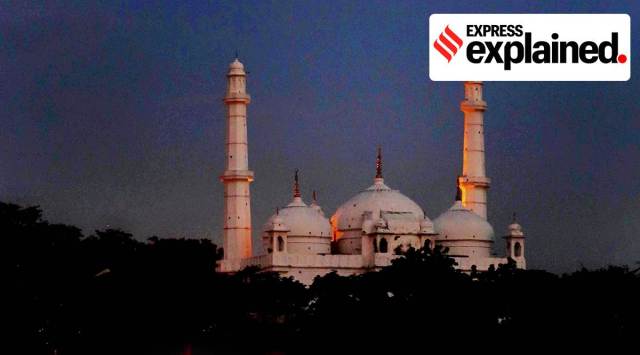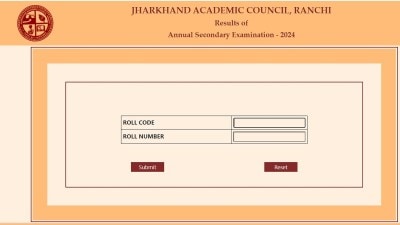- India
- International
Explained: Lucknow’s Laxman connection, and a large mosque built in the reign of Aurangzeb
While Lucknow's name has long been associated with Laxman in the popular imagination, speculation about its possible renaming gained ground after the late BJP leader Lalji Tandon wrote a book, Ankaha Lucknow, in 2018, in which he lamented the loss of the city’s connection with the brother of Lord Ram.
 Tile wali masjid now stands at the site of what is believed to have been an ancient settlement. Vishal Srivastav/Archive
Tile wali masjid now stands at the site of what is believed to have been an ancient settlement. Vishal Srivastav/ArchiveA tweet by Uttar Pradesh Chief Minister Yogi Adityanath welcoming Prime Minister Narendra Modi to Lucknow, “the city of Laxman”, on May 16 has triggered fresh reports of a possible change of the name of the state capital to “Laxmanpuri”.
“Sheshavatar Bhagwan Shri Laxman ji ki paawan nagari Lucknow mein aapka haardik swaagat wa abhinandan (You are welcome in the sacred city of Lord Laxman, Lucknow),” he tweeted along with a picture of himself and Governor Anandiben Patel with Modi.
While there is no official proposal yet to change the name, the Chief Minister’s tweet came three days after the Mayor of the city spoke about the Lucknow Municipal Corporation’s plan to erect a 151-foot statue of Laxman on the bank of the Gomti. Both Mayor Sanyukta Bhatia and BJP leaders have said Lucknow’s ancient connection with Laxman must be re-established.
While the city’s name has long been associated with Laxman in the popular imagination, speculation about its possible renaming gained ground after the late BJP leader Lalji Tandon wrote a book, Ankaha Lucknow, in 2018, in which he lamented the loss of the city’s connection with the brother of Lord Ram. Over the years, Lucknow’s “Laxman ka tila” had been forgotten, Tandon wrote — and the only remaining association with the historic tila (mound) was the Tile wali masjid, a mosque built by a Mughal governor during the reign of Aurangzeb.
Following the publication of the book, BJP corporators in the Nagar Nigam floated a proposal to build a statue of Laxman near the Tile wali masjid. Soon afterward, veteran BJP leader Kalraj Mishra, now Governor of Rajasthan, said there was no harm in changing the name of Lucknow to Laxmanpuri if everyone agreed.
शेषावतार भगवान श्री लक्ष्मण जी की पावन नगरी लखनऊ में आपका हार्दिक स्वागत व अभिनंदन… pic.twitter.com/zpEmxzS3OE
— Yogi Adityanath (@myogiadityanath) May 16, 2022
Tandon’s book
Two of the chapters in Ankaha Lucknow, launched by Vice President M Venkaiah Naidu in May 2018, are titled ‘Laxman Tila’ and ‘Virasat ke saath chher-chhar’ (Messing with heritage). Tandon wrote, “Purana Lucknow Laxman Tile ke aas paas basaa tha. Chaahe Mughal kaal ho, Aurangzeb ke samay ek masjid ka nirmaan ho, Mohammed Ali Shah ka mazaar ho, Naubat Khana ho, Itra Bagh ho, Alvida Ground ho, chaahe angrezon ka kaal ho, Nawabi kaal ho, aazaadi ke kuchh dashak baad ho… Laxman Tila hamesha Laxman Tila raha. Ab Laxman Tila ka naam poori tarah mitaa diya gaya hai aur yeh sthan aaj Tile wali masjid ke naam se jaana ja raha hai. (Old Lucknow was settled around Laxman Tila. During the time of the Mughals, the Nawabs, the British, and until a few decades after Independence; the construction of the mosque in Aurangzeb’s reign, mazaar of Ali Shah, Naubat Khana, Alvida Ground, Itra Bagh, Laxman Tila remained Laxman Tila. But now its name has been removed, and that place is known by the name of Tile wali masjid.)”

The name of the city had changed from “Laxmawati to Laxmanpur to Lakhnawati to finally Lucknow”, he wrote. He said the city had been given to Laxman by Ram, and Aurangzeb had built the Tile wali masjid on the mound of the ancient settlement. The mound should be explored for archaeological remains, Tandon said.
Statue demand
In June 2018, BJP corporators Rajnish Gupta and Ram Krishna Yadav brought a proposal before the municipal board to erect a statue of Laxman near the site of the ancient Laxman ka tila. This faced opposition from non-BJP parties and Muslim clerics. A budget allocation was made, but the proposal was put on ice after the pandemic struck in 2020.
“We opposed the proposal saying there was already a statue of Laxman by the Gomti, which was not maintained well, so what was the need for another statue? We also said that sanatan Hindu dharma does not speak about installing statues of gods by the roadside, where they cannot be properly respected,” said Congress spokesperson Mukesh Singh Chauhan, who was a corporator at the time.
Mayor Bhatia has announced a 151-foot statue of Laxman would be built at Jhulewala Vatika near Hanuman Temple. The proposal has been sent to the government, and a budget of Rs 15 crore set aside, she said.
She told The Indian Express that Lucknow was originally called Laxmanpuri, and the proposed statue would be a prerna sthal and a gateway to Ayodhyapuri, the city of Ram. A museum would tell the coming generations about Laxman’s contributions, she said.
Historian’s view
In his book Purana Lucknow, historian Abdul Halim Sharar wrote that while no one knows for sure who established the city and how it got its name, based on certain findings and ancient folklore, it can be surmised that after Lord Ram returned from exile, this land was given to his brother Laxman.
A hamlet was established around a tila, which came to be known as Laxmanpur, and the tila became popular as Laxman Tila, Sharar wrote. It was believed that a cave lay concealed within the depths of the tila, he wrote.
Newsletter | Click to get the day’s best explainers in your inbox
More Explained
EXPRESS OPINION
Apr 19: Latest News
- 01
- 02
- 03
- 04
- 05








































